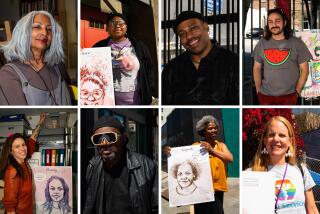The KAOS Theory : Ben Caldwell’s Multimedia Sanctuary Provides a Cultural Bridge
Ben Caldwell can do one better than a scrapbook.
His history and the connecting dots unfold in vivid, video color--cassette after cassette of memory maps.
On a recent afternoon, a little more than a dozen days after a police raid shut down his popular Thursday night hip-hop workshop, Project Blowed, for alleged overcrowding, Caldwell’s usually sonorous baritone has a trace of weariness wearing the edges.
He eases another tape in the deck, the black screen shimmers alive as GeeDawg and the now-late Joe Boy bob their heads to a beat flavored by L.A. street rhythms.
The rap’s hook, “They Don’t Understand,” is a sentiment Caldwell, the director of the KAOS Network, has been pondering since that bad-dream evening of Jan. 4, when police used force to disperse the crowd at the Leimert Park venue.
(Monday, Caldwell was charged with single counts of overcrowding, failing to maintain an unobstructed aisle to required exits and operating without a valid permit from the city Fire Department. He faces up to six months in jail and a $1,000 fine for each charge. Caldwell could not be reached for comment Monday.)
While the Los Angeles Police Department continues an investigation into allegations that officers used excessive force, Caldwell is wrestling with the suddenly common notion that he operates a rap club. In fact, Project Blowed is just one aspect of Caldwell’s multimedia operation.
And for those who have spent any time in the neighborhood, especially community youth, it is quite clear: Caldwell has been a constant when many things were not.
About 12 years ago, he first opened shop with Video 3333, a project he ran out of a smaller storefront just around the corner from where KAOS currently stands, just off Crenshaw Boulevard and 43rd Place. At the outset, the idea was to introduce neighborhood students to the art and power of media, which was important to Caldwell, who is part of the illustrious group of black filmmakers--Jamaa Fanaka, Charles Burnett and Julie Dash--who matriculated at UCLA.
It was at Video 3333 that Caldwell dreamed up a project that captured the spirit of early ‘80s hip-hop and boasted rapper Yo Yo among its alumni. But it was more than just a place for kids to lip-sync to Madonna or Prince. It was a safe zone that kept them off streets, while at the same time expanded their horizons.
“I’d been reading statistics that junior to senior high was the hardest group to work with,” Caldwell recalled. “It’s when all the changes are happening. But once you learn how to capture their attention, they are the richest group to satiate.”
So Caldwell set out a feast.
“If you just preach to them they don’t hear it,” says Charletta Johnson, the high school English teacher who made introductions for Yo Yo and Caldwell. “But if you show them it makes a difference.”
With her own eyes Johnson recently witnessed an even more dramatic change in another former student, Glen Williams (GeeDawg), whose world had been confined to the brutal life-rhythms of his gang set.
“I had my brushes when I was involved with the street life,” Williams says, “but Ben helped me out a lot when I was trying to do my music thing and get it off the ground.” A video yearbook, produced by Williams with the help of Caldwell at Centennial High School in Compton, was his ticket to a scholarship to CalArts. Currently, he’s enrolled at UCLA in a music business program. “If it weren’t for Ben, I wouldn’t have this many things under my belt. It’s just been a steady flow, a domino effect.”
In another region of his KAOS outreach, Caldwell nurtures Project Blowed.
*
Two years ago, Caldwell was approached by a collective of young poets and musicians who had been spending their Thursday nights free-styling at a neighborhood cafe, the Goodlife, and were looking for a new venue. He agreed, conditionally: “This isn’t a club. It’s a workshop. I set down the rules. No drinking. No fighting. No smoking--of any kind.”
Every Thursday night this cluttered room with its scuffed floors and walls is ambiently lit and culturally adorned, making the magic metamorphosis from classroom to hands-on workshop.
Attendees arrive from as far away as Long Beach and Pacoima. “They tell me that this is church for them,” Caldwell said. “It provides the same thing that a traditional church does, a place for them to release their burdens and stress.”
Caldwell curates behind the scenes, incorporating various threads of his programming. CalArts students participate in the workshop for class credit.
As part of KAOS Network’s programming, teens from Dorsey and Crenshaw high schools, who participate in Caldwell’s after-school program, can hone their editing and computer skills.
“To me, the KAOS Network provides a forum for the young people who are striving to be poets, musicians, filmmakers, engineers,” says Trudy Goodwin Barnes, whose son, Bectemba, attends Project Blowed. “It also helps them to create a sense of who they are--culturally. And I think that Ben’s contribution has a positive impact on the youth of the inner city and therefore their impact on the world.”
Caldwell has attempted a wide reach, even with a modicum of funds. He keeps his head above water through an Artist-in-Community grant from the City of Los Angeles Cultural Affairs Department, while KAOS has received funds for a video workshop since 1991 from CalArts’ Community Arts Partnership.
“It’s been incredibly beneficial to our students not only to work with an award-winning filmmaker like Ben,” says Glenna Avila, director of the CalArts program, “but to see what it is to have a commitment to a community. He works on enabling young people to find a voice and stay focused on issues that affect the community, and has educated our students to what those cultural issues are.”
Soon, through USC’s Annenberg School of Communication, KAOS will be outfitted with a vastly improved computer setup. The rest, Caldwell patches together through donations to Project Blowed and his professor’s salary from CalArts. In other words, whatever it takes.
“He is one of the people who has really made a commitment to the Leimert Park area and hung in there through real bad times,” says Adolfo Nodal, general manager of the city’s Cultural Affairs Department.
*
Though there are plans to expand, Caldwell will never let go of this little laboratory. He doesn’t think that the workshop has outgrown its digs, instead he believes that its intimate size is an integral part of forming community and forging identity.
“On some level,” Caldwell says, “I see why some of the adults don’t understand, ‘cause the kids look strong. They come from strong parents, who are middle class, upper-middle class, and they’ve been brought up to be proud. Like my own daughter. If I didn’t know them I may have to have someone talk to me too,” says Caldwell with a laugh.
“If there are a lot of black kids pouring out into the street that’s not necessarily a sign that something bad is going to happen. . . . I think that’s part of my education for the community” . . . for the adults, anyway. The kids are already on that tip.
“I look at Project Blowed as a real effective connection. A meeting of the minds. It’s solely based on positivity and the upliftment of younger people and their aspirations,” says Bectemba Barnes, a Culver City High School senior, known around the workshop as Metamorphosis.
And Glen Williams Jr., too, knows about change. “You hear a lot about the problems, the reasons why things can’t be done. I would want my story to be a sense of inspiration, It’s kind of like having an effect on your family. It’s right in the family and right in the neighborhood. That’s all that you need.”
More to Read
The biggest entertainment stories
Get our big stories about Hollywood, film, television, music, arts, culture and more right in your inbox as soon as they publish.
You may occasionally receive promotional content from the Los Angeles Times.










